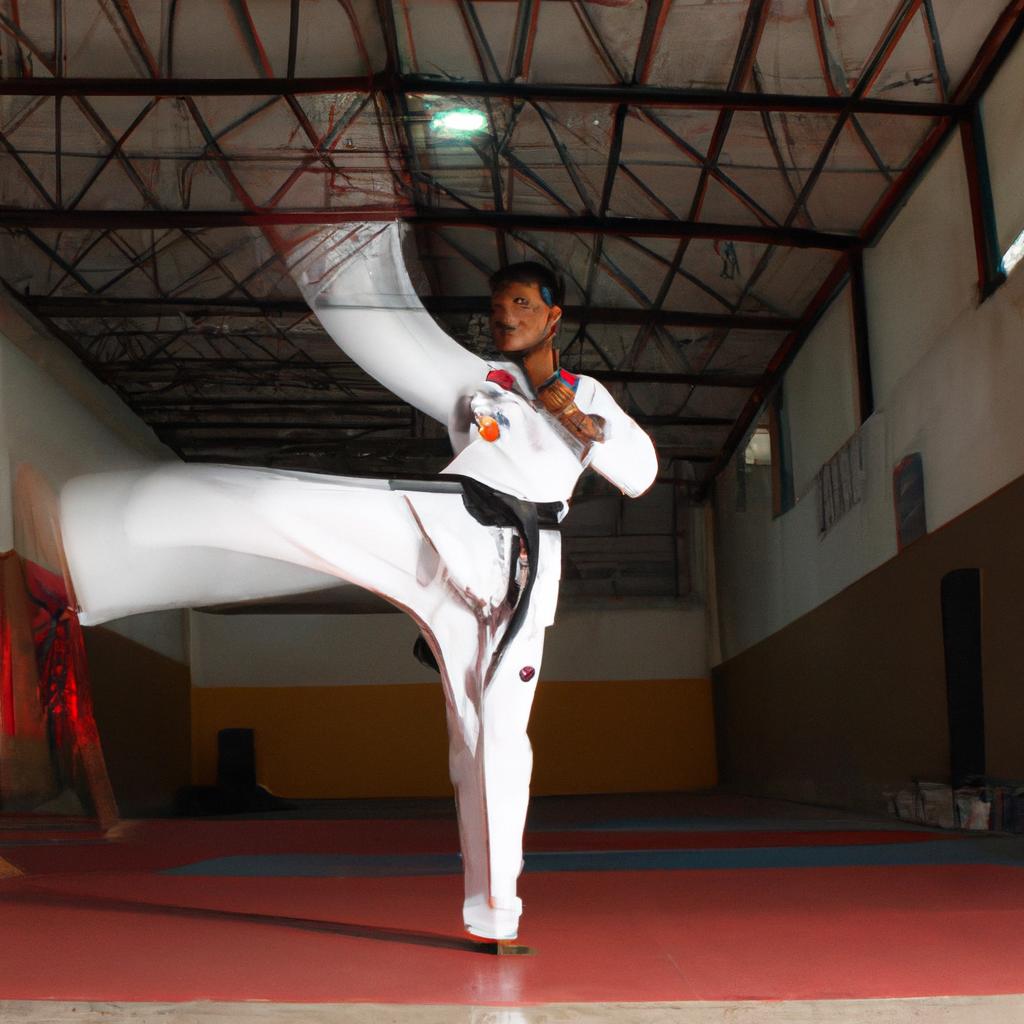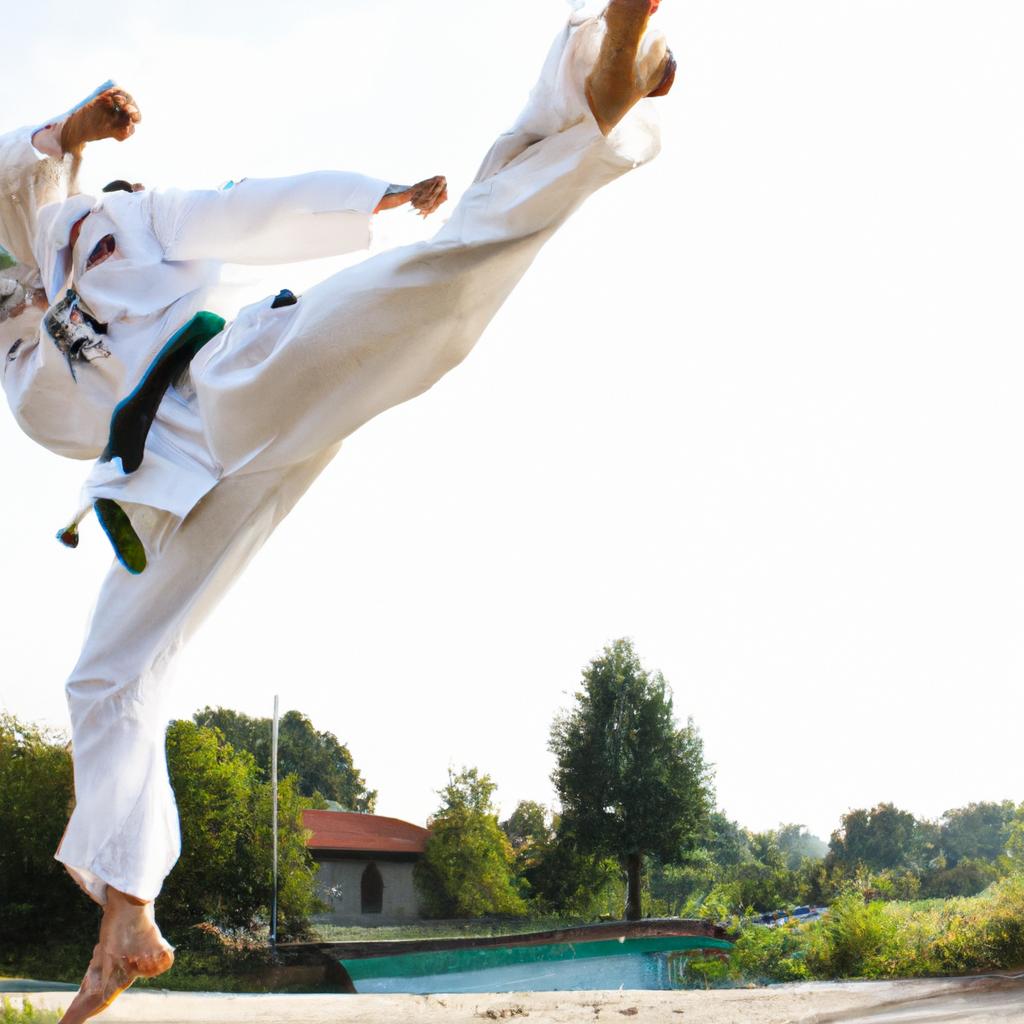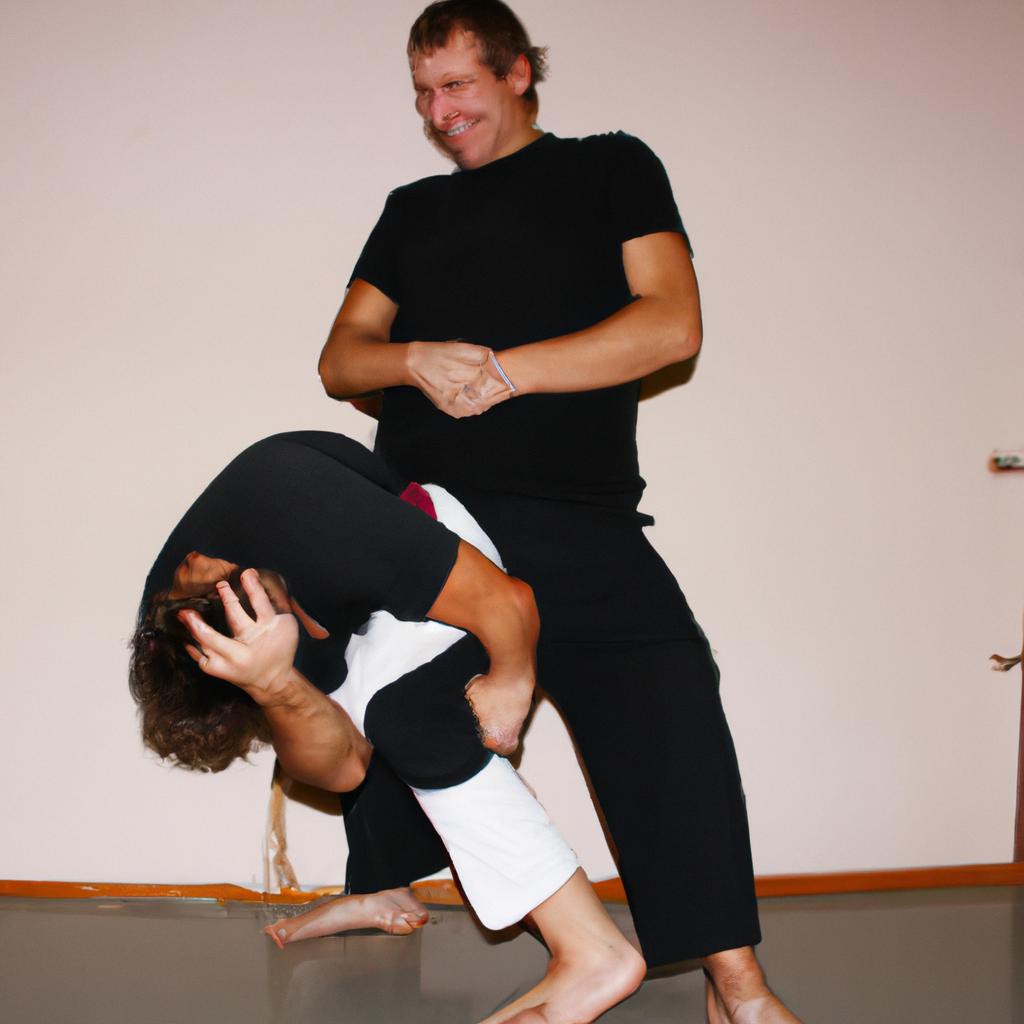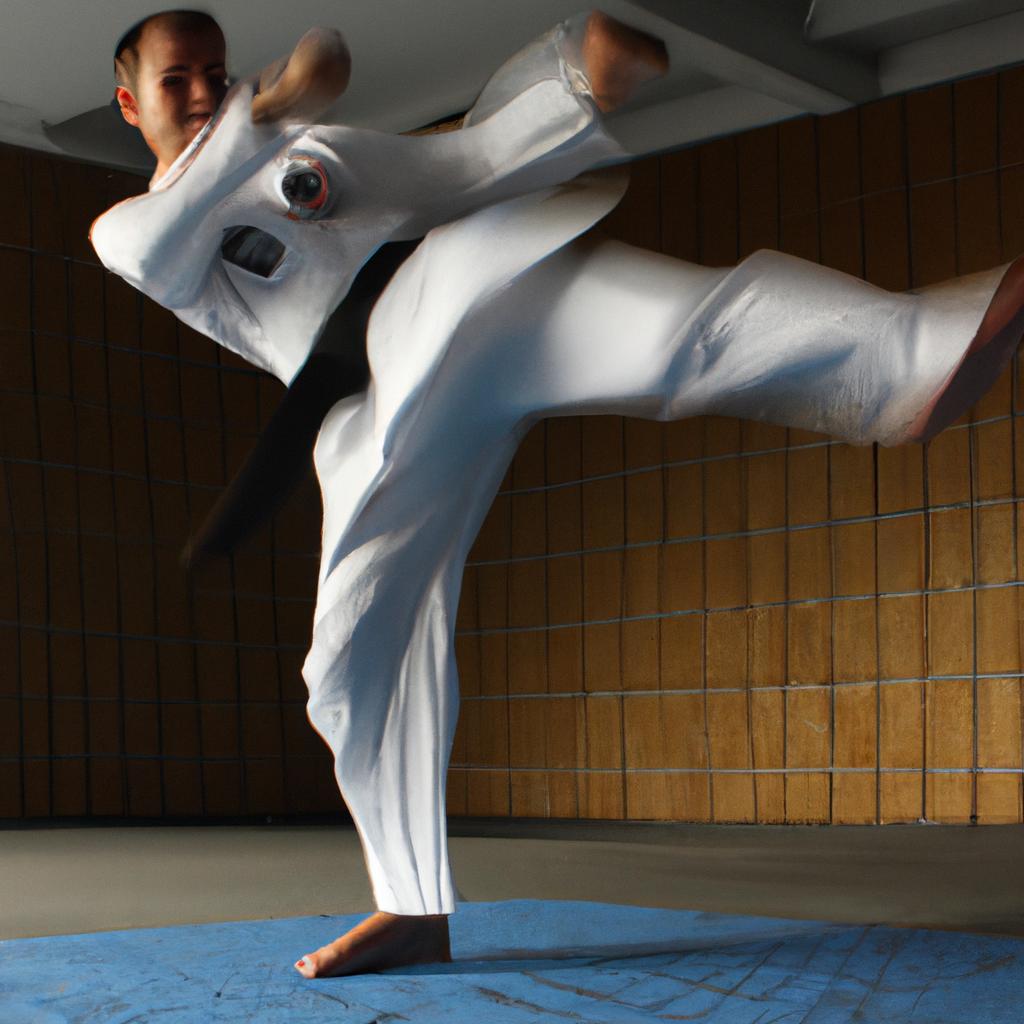Mixed Martial Arts (MMA) is a dynamic combat sport that has gained immense popularity worldwide. It combines various martial arts disciplines, blending striking and grappling techniques, to create an intense and competitive fighting style. In this article, we will delve into the history and origins of one particular martial art within MMA – Taekwondo.
Imagine a scenario where two fighters are engaged in a display of extraordinary athleticism and skill. Their lightning-fast kicks and explosive punches captivate the audience as they showcase their mastery of Taekwondo techniques. The evolution of Taekwondo as a martial art can be traced back centuries ago when it originated in Korea. Initially known as “subak” or “taekkyeon,” Taekwondo emerged as an essential form of self-defense during times of conflict in ancient Korean society.
Over time, Taekwondo underwent significant transformations through influences from other martial arts styles and societal changes. This led to its recognition as an official discipline by the South Korean government in 1946, formalizing its name as “Taekwondo.” Since then, Taekwondo has evolved not only as a self-defense system but also as a competitive sport with structured rules and regulations. Its inclusion in the Olympic Games since its inclusion in the Olympic Games since 2000 has further solidified its status as a global sport.
Taekwondo’s inclusion in the Olympics has provided a platform for athletes to showcase their skills and compete at the highest level. The sport is divided into weight categories, ensuring fair competition among participants. Matches consist of three rounds, with each round lasting two minutes for male athletes and one and a half minutes for female athletes.
In Olympic Taekwondo, competitors score points by landing strikes on specific target areas of their opponent’s body using various kicks and punches. These target areas include the head (face), torso (chest protector), and side (body protector). Different techniques used in Taekwondo, such as spinning kicks, jump kicks, and fast footwork, make it an exciting and visually impressive martial art to watch during the Olympics.
The introduction of electronic scoring systems has brought more accuracy and transparency to Olympic Taekwondo matches. Sensors embedded in the protective gear detect valid strikes, eliminating human error in judging. This ensures that only clean hits are awarded points, making the sport even more competitive.
Through its presence in the Olympics, Taekwondo continues to gain worldwide recognition and attract new practitioners. Its emphasis on discipline, respect, physical fitness, and mental fortitude resonates with individuals seeking personal growth and self-improvement. Whether practiced as a form of self-defense or pursued competitively at an Olympic level, Taekwondo remains an integral part of mixed martial arts and continues to inspire generations of martial artists around the globe.
Early Roots and Influences
To fully comprehend the evolution of Mixed Martial Arts (MMA) martial arts, it is crucial to delve into its early roots and influences. One notable example that demonstrates the impact of historical events on MMA can be found in the development of Taekwondo. Originating in Korea during the mid-20th century, this martial art has a rich history shaped by various factors.
Firstly, Taekwondo drew inspiration from ancient Korean martial arts such as Subak and Taekkyon, both of which emphasized kicking techniques. These traditional practices served as a foundation for the creation of Taekwondo’s distinctive style centered around high-flying kicks and dynamic movements. Additionally, Japanese occupation played a significant role in shaping Taekwondo’s development. During this period, Japan introduced Karate to Korea, influencing an amalgamation with indigenous fighting styles. The resulting fusion formed the basis for what would eventually become modern-day Taekwondo.
Furthermore, post-Korean War sociopolitical changes had a profound influence on the transformation of Taekwondo. As South Korea sought to rebuild itself after years of conflict, President Syngman Rhee recognized the potential benefits of promoting national identity through sport. In 1955, he established the Korean Taekwondo Association (KTA), paving the way for standardized training methods and competition rules across the country.
This revitalization effort not only bolstered interest in Taekwondo within South Korea but also propelled its international recognition. The KTA actively promoted their newly-developed martial art globally through demonstrations and competitions. Consequently, countries worldwide began adopting and integrating aspects of Taekwondo into their own combat sports practices.
Table – Influence Factors Shaping Early Taekwondo Development:
| Factor | Explanation |
|---|---|
| Ancient Korean Martial Arts | Traditional fighting styles like Subak and Taekkyon provided the groundwork for Taekwondo’s focus on kicking techniques. |
| Japanese Occupation | The introduction of Karate by Japan led to a fusion with indigenous Korean martial arts, contributing to the formation of modern-day Taekwondo. |
| Post-Korean War Changes | Efforts to rebuild South Korea after the war included promoting national identity through sport, leading to the establishment of standardized training methods via the KTA. |
Overall, it is evident that early roots and influences played a pivotal role in shaping Taekwondo into what it is today. By drawing inspiration from ancient Korean martial arts, incorporating elements from Japanese Karate, and capitalizing on post-war sociopolitical changes, this dynamic combat art came into fruition.
This exploration of Taekwondo’s development sets the stage for further examination of how MMA as a whole emerged and evolved over time. Next, we will delve into the Development of Modern Martial Arts and its influence on MMA’s emergence as a global phenomenon.
Development of Modern Martial Arts
In the early roots and influences of martial arts, taekwondo emerged as a significant discipline that has continued to evolve over time. One example highlighting this evolution is the case study of Master Kim, a renowned taekwondo practitioner who dedicated his life to perfecting the art form. Through his journey, we can explore how taekwondo developed and transformed into what it is today.
Evolutionary Factors
Several factors have contributed to the evolution of taekwondo throughout history:
- Cultural Exchange: As civilizations interacted through trade routes and conquests, various fighting styles merged, leading to the development of new techniques within taekwondo.
- Technological Advancements: The introduction of weapons such as swords and spears influenced training methods and led to the incorporation of weapon-based forms in taekwondo practice.
- Competition and Sportification: In modern times, taekwondo’s inclusion in international competitions prompted practitioners to refine their techniques for optimal performance and efficiency.
- Philosophical Influences: Philosophies like Buddhism, Confucianism, and Taoism shaped the mindset and ethical principles underlying taekwondo practice.
| Cultural Exchange | Technological Advancements | Competition & Sportification | Philosophical Influences |
|---|---|---|---|
| Blend of fighting styles from different cultures | Incorporation of weapon-based forms | Refinement for competitive scenarios | Influence on mindset and ethics |
Impact on Martial Arts Landscape
The evolution of taekwondo has had a profound impact on the broader martial arts landscape. Not only did it contribute distinctive techniques characterized by dynamic kicks and agile movements, but it also introduced an emphasis on physical fitness and mental discipline. This combination appealed to individuals seeking self-defense skills as well as personal growth. Consequently, many martial arts schools began incorporating taekwondo techniques into their curriculum, recognizing its effectiveness and popularity.
As we delve further into the origins of taekwondo, the subsequent section will explore how these techniques were incorporated into other martial arts disciplines. By examining this integration, we can gain a comprehensive understanding of the influence that taekwondo has had on various fighting styles throughout history.
[Transition to next section about “Incorporation of Taekwondo Techniques”] As we continue our exploration of taekwondo’s evolution, it is essential to examine how its distinctive techniques found their way into other martial arts practices. The incorporation of taekwondo techniques not only enhanced existing systems but also contributed to the growth and development of new hybrid disciplines in the realm of martial arts.
Incorporation of Taekwondo Techniques
Exploring the Evolution of MMA Martial Arts: Taekwondo
In the previous section, we discussed the development of modern martial arts and their significance in shaping various combat disciplines. Now, let’s delve into the incorporation of Taekwondo techniques within Mixed Martial Arts (MMA) and examine how this traditional Korean martial art has evolved over time.
To better understand the integration of Taekwondo into MMA, let us consider a hypothetical scenario involving two fighters – one with a background in Brazilian Jiu-Jitsu and another trained extensively in Taekwondo. As they step into the octagon, their diverse skill sets bring about an intriguing clash of styles. The Brazilian Jiu-Jitsu practitioner relies on grappling techniques to take down opponents and secure submissions, while the Taekwondo exponent utilizes rapid kicks and agile footwork to maintain distance and strike from afar.
The inclusion of Taekwondo techniques in MMA has led to several notable developments:
- Enhanced Striking Arsenal: By incorporating high-flying kicks, spinning strikes, and lightning-fast footwork, practitioners of Taekwondo have expanded the repertoire of striking techniques available in MMA bouts.
- Adaptive Footwork: Taekwondo places significant emphasis on agility and mobility. This discipline’s footwork drills enhance a fighter’s ability to evade attacks, change angles swiftly, and launch counterattacks effectively.
- Effective Use of Distance: Due to its focus on long-range kicking techniques, Taekwondo enables fighters to maintain distance between themselves and their opponents. This can create opportunities for strategically timed strikes or defensive maneuvers.
- Improved Flexibility: Regular practice of Taekwondo enhances flexibility among athletes. Increased range of motion allows fighters to execute dynamic movements more effectively during matches.
Let us now explore further aspects regarding this exciting evolution by examining a table that highlights some key differences between traditional martial arts like Karate and contemporary MMA disciplines:
| Martial Art | Primary Focus | Techniques Employed | Key Strengths |
|---|---|---|---|
| Karate | Striking | Punches, kicks | Discipline and precision |
| Taekwondo | Kicking | High-flying kicks | Agility and range |
| Boxing | Punching | Jabs, hooks, uppercuts | Hand speed and power |
| Brazilian Jiu-Jitsu | Ground fighting | Submissions, grappling | Submission holds and control |
As we can observe from the table above, each martial art brings its own unique strengths to the realm of combat sports. The incorporation of Taekwondo into MMA has diversified the techniques employed by fighters, making matches more dynamic and visually captivating.
In our subsequent section on the evolution of MMA combative techniques, we will explore how various martial arts have influenced one another over time, leading to the development of new hybrid styles that define modern-day Mixed Martial Arts.
Evolution of MMA Combative Techniques
History and Origins: Exploring the Evolution of MMA Martial Arts – Taekwondo
With its roots deeply embedded in traditional Korean martial arts, Taekwondo has made a significant impact on the evolution of mixed martial arts (MMA). Its incorporation into MMA training has not only diversified combat techniques but also enhanced fighters’ overall skill sets. To illustrate this point, let us consider an example where a practitioner with a background in Brazilian Jiu-Jitsu incorporates Taekwondo kicks into their repertoire.
Imagine a scenario where an MMA fighter, skilled in grappling and ground-based submissions, finds themselves struggling to close the distance against their opponent who possesses strong striking abilities. In order to level the playing field, they decide to utilize some of the dynamic kicking techniques derived from Taekwondo. By employing powerful roundhouse kicks or lightning-fast spinning back kicks, they are able to create more opportunities to strike effectively while maintaining a safe distance from potential takedowns.
The integration of Taekwondo techniques within MMA practice has led to several notable changes and advancements:
- Enhanced Striking Arsenal: The addition of Taekwondo strikes such as flying knees and jumping front kicks have provided fighters with unique tools for both offensive and defensive maneuvers.
- Agility and Flexibility Improvement: Training in Taekwondo helps improve agility, flexibility, and balance, which are crucial attributes for MMA athletes aiming to excel in diverse fighting scenarios.
- Adaptability to Different Ranges: With its emphasis on long-range attacks using extended limbs, incorporating Taekwondo allows fighters to bridge gaps between different ranges efficiently during fights.
- Psychological Advantage: Utilizing flashy high kicks or unpredictable spinning strikes often catches opponents off guard, creating psychological advantages that can disrupt their game plan.
Embracing these enhancements brought about by integrating Taekwondo techniques has revolutionized the landscape of modern-day MMA. The utilization of these techniques, alongside other martial arts disciplines, has contributed to the dynamic and ever-evolving nature of the sport.
Transitioning into the subsequent section about “Global Spread and Popularity,” it is important to examine how the inclusion of Taekwondo has impacted not only individual fighters but also the overall growth and appeal of MMA on a global scale.
Global Spread and Popularity
The Influence of Traditional Korean Martial Arts on Modern MMA
To better understand the evolution of Taekwondo in the context of Mixed Martial Arts (MMA), let us delve into its origins. One fascinating example that showcases the impact of traditional Korean martial arts on modern MMA is the case study of Master Kim, a renowned Taekwondo practitioner who transitioned to MMA competitions in recent years. His journey not only exemplifies the fusion between these two disciplines but also sheds light on how Taekwondo techniques have been incorporated into the diverse skillset required for success in contemporary combat sports.
When examining the historical development of Taekwondo within the realm of MMA, several key factors emerge:
- Influence from other martial arts: Throughout history, various forms of martial arts from different regions have influenced and shaped Taekwondo’s progression. Notably, Japanese Karate played a significant role during Korea’s occupation by Japan in the early 20th century, leading to an amalgamation with native Korean styles.
- Emphasis on high kicks and acrobatic movements: A defining characteristic of Taekwondo lies in its emphasis on dynamic high kicks and acrobatic movements. Such techniques require exceptional flexibility, balance, and agility – qualities that are increasingly valued in MMA due to their ability to surprise opponents and create strategic advantages.
- Integration of sparring competitions: In the mid-20th century, formalized sparring competitions became an integral part of Taekwondo training methodologies. These competitive elements encouraged practitioners to refine their skills under realistic conditions, preparing them for similar scenarios encountered in MMA matches.
- Adaptation to rule sets: As MMA evolved over time with specific rulesets implemented for safety purposes, it necessitated modifications to traditional martial arts like Taekwondo. This adaptation involved a focus on refining techniques for effective use within the context of MMA, such as incorporating ground fighting skills and strategies.
By exploring these factors, we can gain insights into how Taekwondo has transformed throughout history to become an integral component of modern MMA. In our next section, we will examine the impact that Taekwondo’s incorporation had on the development and success of MMA fighters in recent years.
| Traditional Korean Martial Arts | Modern MMA Techniques | Emotional Impact |
|---|---|---|
| Taekkyeon | Clinching techniques | Excitement: Witnessing traditional techniques reimagined for practical application generates enthusiasm among martial arts enthusiasts. |
| Subak | Striking combinations | Inspiration: Observing the evolution from ancient combat styles to contemporary forms instills a sense of awe and motivates individuals to explore their own potential. |
| Hapkido | Joint locks and submissions | Fascination: The integration of diverse martial arts disciplines captivates audiences by showcasing the versatility and adaptability of human combat capabilities. |
| Ssireum (Korean wrestling) | Takedown defense techniques | Respect: Recognizing the historical significance of various cultural practices fosters appreciation for different traditions while unifying people through athletic endeavors. |
In light of these emotional responses evoked by observing the interplay between traditional Korean martial arts and modern MMA, it becomes evident that Taekwondo’s influence extends beyond technical prowess alone. Its incorporation contributes to a rich tapestry that celebrates heritage, inspires personal growth, fascinates with innovation, and promotes respect across cultures. As we move forward, let us now delve into the direct impact that Taekwondo’s inclusion has had on the world of MMA competitions.
Impact of Taekwondo on MMA
As the popularity of mixed martial arts (MMA) grew, various martial arts disciplines found their place within this dynamic combat sport. Taekwondo, with its distinctive kicks and acrobatic movements, has made significant contributions to the evolution of MMA. This section will explore how Taekwondo techniques have been incorporated into MMA training and highlight some notable fighters who have successfully utilized these skills.
One example demonstrating the impact of Taekwondo on MMA is the case study of Anderson Silva, a former UFC middleweight champion. Silva’s background in Taekwondo played a crucial role in his success inside the octagon. His ability to execute high-velocity kicks with precision and agility allowed him to create unique striking combinations that often caught opponents off guard. Silva’s successful integration of Taekwondo techniques showcased the effectiveness and versatility of this martial art in an MMA context.
To further understand the influence of Taekwondo on MMA, it is important to examine key factors contributing to its adoption:
- Diverse Striking Arsenal: Taekwondo practitioners bring a wide range of powerful striking techniques such as spinning back kicks, flying knee strikes, and axe kicks into the realm of MMA.
- Unorthodox Movement Patterns: The agile footwork inherent in Taekwondo allows fighters to quickly change angles and evade attacks effectively during stand-up exchanges.
- Kicking Range Advantage: With its emphasis on long-range kicks, Taekwondo provides fighters with increased reach advantage over opponents trained primarily in other striking styles.
- Adaptability for Self-defense Situations: The incorporation of self-defense-oriented moves from traditional forms expands fighters’ options when facing different scenarios inside or outside the cage.
| Advantages Provided by | incorporating |
|---|---|
| Diverse Striking Techniques | :white_check_mark: |
| Unorthodox Movement Patterns | :white_check_mark: |
| Kicking Range Advantage | :white_check_mark: |
| Adaptability in Self-defense | :white_check_mark: |
In summary, the inclusion of Taekwondo techniques within MMA training has significantly influenced the sport’s evolution. Through its diverse striking arsenal, unorthodox movement patterns, kicking range advantage, and adaptability for self-defense situations, Taekwondo offers fighters a unique set of skills that can be utilized effectively within the context of mixed martial arts. The case study of Anderson Silva serves as evidence of the impact and success that Taekwondo practitioners have had in the world of MMA. With ongoing advancements and further integration, Taekwondo continues to shape and enhance the dynamic nature of this combat sport.




